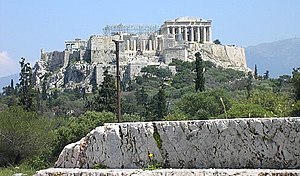Pnyx
English > Greek (Woodhouse)
Wikipedia EL
Η Πνύκα (η Πνύξ, της Πνυκός ή Πυκνός) είναι η θέση - περιοχή όπου συγκαλούνταν η Εκκλησία του δήμου, δηλαδή η συνέλευση των Αθηναίων, στην Αρχαία Αθήνα, από τον 6ο αιώνα μέχρι το τέλος του 4ου αιώνα π.Χ.. Βρίσκεται στο μέσον της κατά διεύθυνση βορρά-νότου λοφοσειράς έναντι και δυτικά της Ακρόπολης και μεταξύ των ακραίων υψωμάτων, του λόφου Νυμφών (βόρειο άκρο) και λόφου Μουσών ή Φιλοπάππου (νότιο άκρο).
Από το αρχαίο βήμα του ιερού χώρου αυτού αγόρευσαν σπουδαίοι πολιτικοί, στρατηγοί και ρήτορες όπως ο Θεμιστοκλής, ο Αριστείδης, ο Περικλής, ο Δημοσθένης, ο Αισχίνης αλλά και στη σύγχρονη εποχή ο Θεόδωρος Κολοκοτρώνης.
Wikipedia EN
The Pnyx (/nɪks, pəˈnɪks/; Ancient Greek: Πνύξ [pnýks]; Greek: Πνύκα, Pnyka) is a hill in central Athens, the capital of Greece. Beginning as early as 507 BC (Fifth-century Athens), the Athenians gathered on the Pnyx to host their popular assemblies, thus making the hill one of the earliest and most important sites in the creation of democracy.
The Pnyx is located less than 1 kilometre (0.62 mi) west of the Acropolis and 1.6 km south-west of the centre of Athens, Syntagma Square.
The Pnyx was used for popular assemblies in Athens as early as 507 BC, when the reforms of Cleisthenes transferred political power to the citizenry. It was then outside the city proper, but close enough to be convenient. It looks down on the ancient Agora, which was the commercial and social centre of the city.
At this site all the great political struggles of Athens of the "Golden Age" were fought out. Pericles, Aristides and Alcibiades spoke here, within sight of the Parthenon, temple of Athena. Here Demosthenes delivered his vilifications of Philip II of Macedon.
Translations
ar: بنيكس; bg: Пникс; ceb: Pnyx; co: Pnici; de: Pnyx; el: Πνύκα; en: Pnyx; eo: Pniko; es: Pnyx; fi: Pnyks; fr: Pnyx; it: Pnice; ja: プニュクス; ko: 프닉스; nl: Pnyx; no: Pnyx; pl: Pnyks; pt: Pnyx; ru: Пникс; sv: Pnyx; tr: Pniks; uk: Пнікс; zh: 普尼克斯

